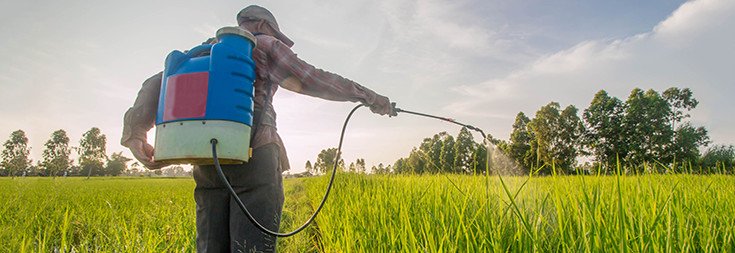EPA Proposes Extended Ban on Neurotoxic Pesticide Sprayed on Crops

The U.S. Environmental Protection Agency (EPA) announced Friday a proposal that would ban a pesticide commonly sprayed on citrus fruits, almonds, and other crops.
Chlorpyrifos has been in use since 1965 as an insecticide for oranges, apples, cherries, grapes, broccoli, and asparagus. Dozens of farmworkers have been sickened by chlorpyrifos is recent years. In September 2014, a coalition of environmental health groups sued the EPA, asking the agency to ban the toxic chemical.
The agency cited scientific evidence in defense of its ban on chlorpyrifos for household use in 2000. Prior to the ban, chlorpyrifos was the most widely used household pesticide in the U.S. Sold as Dursban, the Dow-made chemical was found in flea collars and was routinely used to kill household pests, such as roaches, termites and ants.
At the time, the agency warned that farmworkers who mixed chlorpyrifos, sold for farms as Lorsban, or applied it using backpack sprayers or open-cab tractors faced a potentially unacceptable level of risk. The agency also said it needed to research how chlorpyrifos drifting from nearby fields or tracked home on clothing put children’s health at risk.
The National Resources Defense Council (NRDC) and Pesticide Action Network North America (PANNA) say that chlorpyrifos interferes with the brain development of fetuses, infants and children. [1] It has also been found to cause genetic damage in children, though it is reversible, and one study linked the insecticide to an increased risk of autism in unborn children.
In the summer of 2007, the EPA reauthorized the use of chlorpyrifos on farms without resolving the farmworkers’ risks or drawing any conclusions concerning potential harm to youngsters. This reauthorization prompted the NRDC and PANNA to petition the agency to enact a larger ban on all uses of chlorpyrifos, but the agency never made a determination about the safety of the pesticide.
But evidence of chlorpyrifos’ toxicity was mounting. The Farm Worker Pesticide Project detected chlorpyrifos in the air outside farmworkers’ homes in 2006. A study published in the journal Pediatrics found that children exposed to high levels of chlorpyrifos had mental and physical delays. And a 3-year study of blood samples from farmworkers in Washington State revealed that some of the farmers working around chlorpyrifos had such depressed levels of vital liver enzymes that researchers concluded that chlorpyrifos use for agricultural purposes warranted further review. [2]
Finally, in the summer of 2014, the NRDC and PANNA filed a lawsuit against the EPA for failing to respond to their 2007 petition. The agency told the court that it would take public comments on the matter for at least 2 months, with a final rule expected in December 2016. That answer didn’t satisfy the court, which responded by accusing the EPA of deliberately avoiding the issue by providing only “a litany of partial status reports, missed deadlines, and vague promises of future action.” [3] [4]
“Although filibustering may be a venerable tradition in the United States Senate, it is frowned upon in administrative agencies tasked with protecting human health,” reads the order [PDF] from the Ninth Circuit Court of Appeals.
The court gave the EPA until today, October 31, to fully respond to the 2007 petition. That is unlikely. The EPA released the following statement addressing the court order:
“EPA is not denying the petition because we are unable to make a safety finding based on the science as it stands currently,” reads the announcement, which disregards the fact that the agency has had nearly a decade to respond. “EPA is not issuing a final revocation rule because we have not proposed it and have not completed our refined drinking water assessment, leaving certain science issues unresolved.”
The EPA says that, instead, it is considering a revocation of all chlorpyrifos tolerances based on the science the agency already has, and that’s music to the NRDC’s and PANNA’s ears.
“If this dangerous, World War II-era chemical does make its final exit from our fields, farmworkers would be safer on the job and children would have the chance to grow up healthier, free from its toxic effects,” writes NRDC Staff Scientist Veema Singla. “We look forward to working with EPA to swiftly implement the ban.”
Sources:
[3] ABC News
[4] Consumerist
